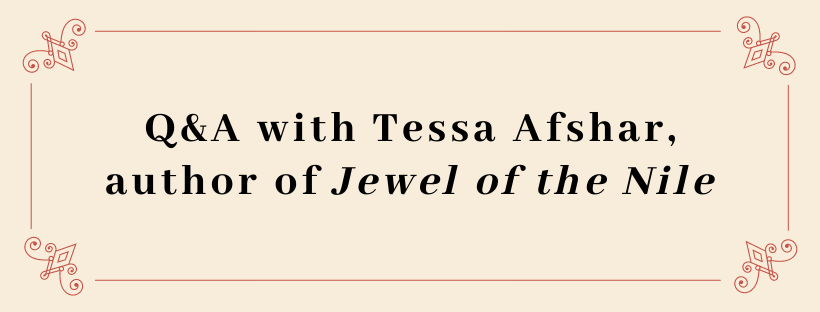
In the new biblical fiction novel Jewel of the Nile by Tessa Afshar, whispered secrets about her parents’ past take on new urgency for Chariline as she pays one last visit to the land of her forefathers, the ancient kingdom of Cush. In the Q&A below with Tessa, discover what inspired the author to write Jewel of the Nile, learn more about the ancient kingdom of Cush, and hear what the author hopes readers will take away from the novel.
What inspired you to write Jewel of the Nile?
A.) When I first began to outline this novel, I wanted to have one of the daughters of Philip the Evangelist as my main character. A short email from a fan upended my plans. A young lady, whose name I don’t remember, wrote to tell me that she loved my books. But, as an African American, she wondered if I ever planned to have a character who looked like her. Because, she explained, it was important for her to see heroines who reflected her.
I might have forgotten her name, but I could not forget her words. I realized that as a writer of biblical fiction I had a responsibility to this young woman and others like her. I ripped up my outline and never looked back. Chariline (pronounced Cara-leen-ee) dominated the page as soon as she showed up. I love this character.
I did keep two of Philip’s daughters for Chariline’s friends. Love at first sight! I hope to write a short story or two featuring at least one them in the near future.
Can you tell us a little about the Kingdom of Cush and what it was like in biblical times?
A.) Located along the banks of the River Nile in what is modern-day Sudan, Cush was an ancient kingdom, shrouded in secrets and legend. Initially, the land was referred to as Nubia, and for over a hundred years, starting in the eighth century BC, the kings of Nubia also ruled as the Pharaohs of Egypt. Afterward, the kings and queens of Cush established an independent and often influential kingdom with vast silver and gold mines, though much of their rich history has been lost to us. Modern archaeologists have discovered over 250 pyramids left behind by this mysterious people. Smaller and more slender than the Egyptian pyramids, they are elegant, colorful structures built to house the dead.
By the first century, when my story takes place, the Cushites possessed a smaller kingdom, barely holding on to independence, with the shadow of Rome hanging over them. Somehow, they managed to prevent the Roman Empire from swallowing them up completely, though they paid well for this privilege. By this time, they had moved their capital to Meroë on the east bank of the Nile, located between the fifth and sixth cataracts in the river. Meroë was a city of twenty thousand, boasting at least two palaces: one housing the king and the other for the queen.
The people of Cush spoke Meroitic, a language that has been preserved in various documents and yet never deciphered, tragically leaving us with a dearth of knowledge regarding this significant civilization. I can’t wait for some brilliant linguist to tackle this language!
The people of Cush flourished on the shores of the middle Nile for over a thousand years. In time, their queens rose to power alongside their kings. Since kings were considered sons of the gods, they were thought to be too important to dabble in the daily responsibilities of ruling a nation. Instead, they were given rule over the temples and religious life of the land, while the queens wielded power over the political and financial realms.
As you can imagine, this mysterious world creates the perfect backdrop for a story about secrets, self-discovery, and forgiveness.
What did you learn while writing this novel?
A.) I fell in love with the world of Cush. The separation between the king and queen and the mysteries that remain after so many centuries intrigue me. I can’t wait for someone to break the code of Meroitic and tell us more about this brilliant people. I also learned about navigating the Nile, the challenge of the six cataracts, and the fascinating world of antiquities that populated its shores, even as late as the first century.
Another wonderful new insight I gained was about the complex world of Roman architecture. My husband found me The Ten Books of Architecture by Vitruvius, the most famous architect at the time in the Roman world. We were amazed by his grasp of engineering and genius for design. Those ancient architects had to know everything from mathematics to soil quality to load bearing to the nature of different woods, concrete, and construction-site management. Truly impressive!
Are there any characters from your other novels in Jewel of the Nile?
A.) Actually, the male protagonist in this novel, Theo, was an important supporting character in Thief of Corinth. And he showed up for a small but important role in Daughter of Rome as well. Speaking of Daughter of Rome, Priscilla and Aquila, who were the central characters in that book, show up to pour some love and wisdom on Chariline in Jewel of the Nile.
What is your hope for readers of Jewel of the Nile?
A.) I hope they learn not to allow their scars to tell their stories. That they see themselves through the prism of faith and inhabit their true worth in Christ. This is ultimately a story about restoration and healing in the deepest soul.


